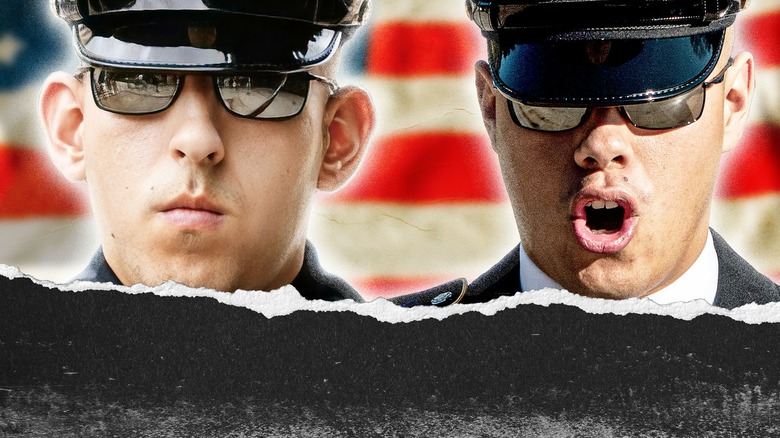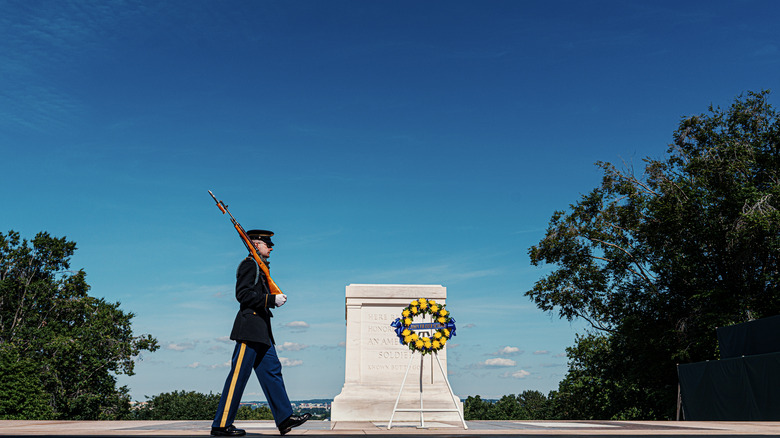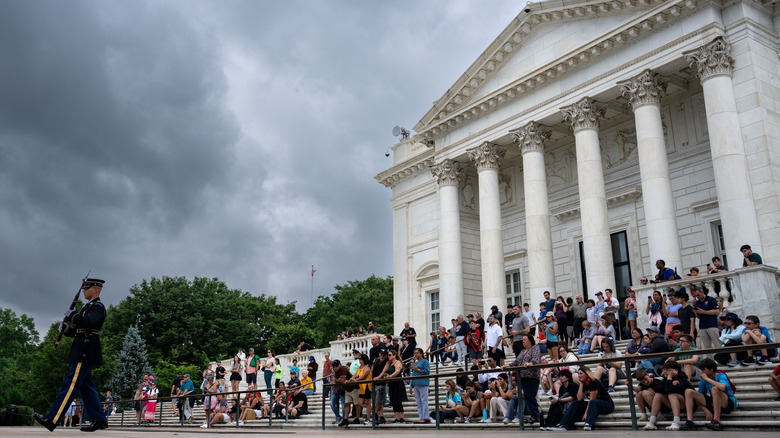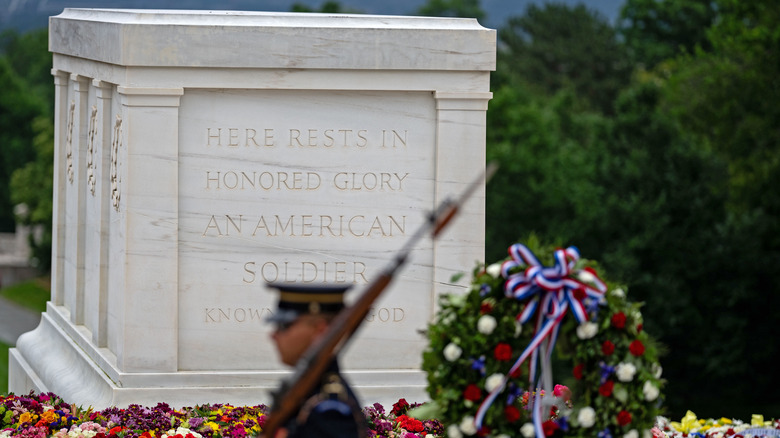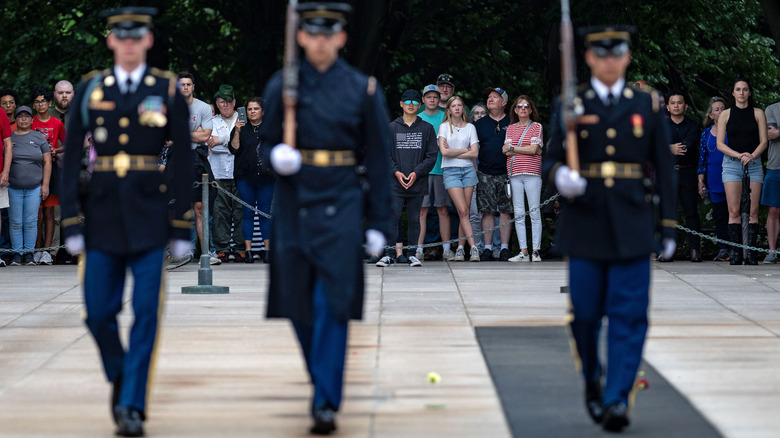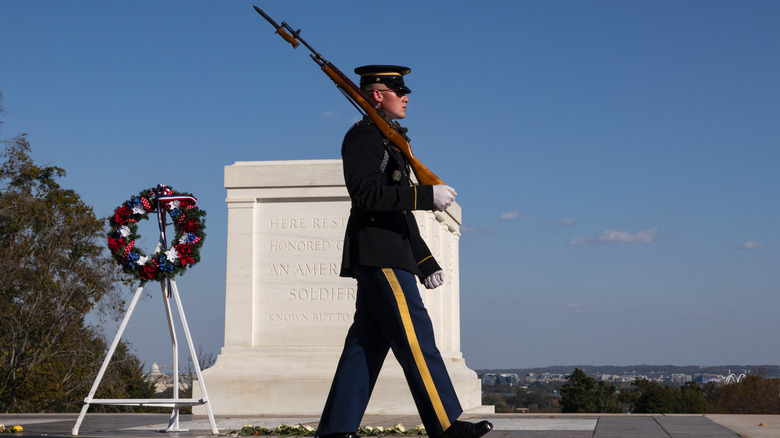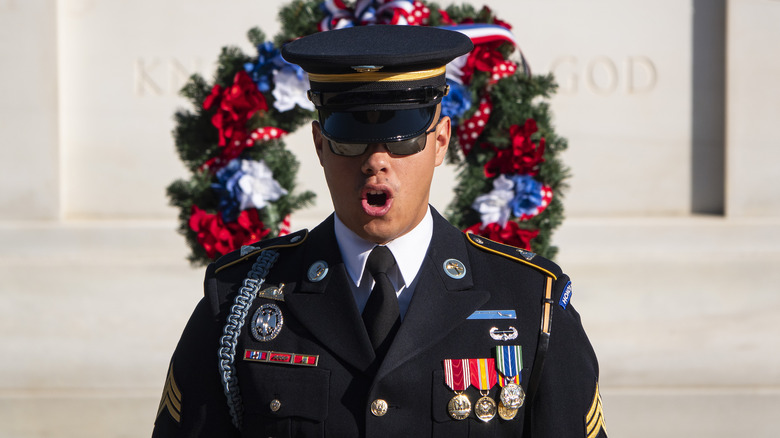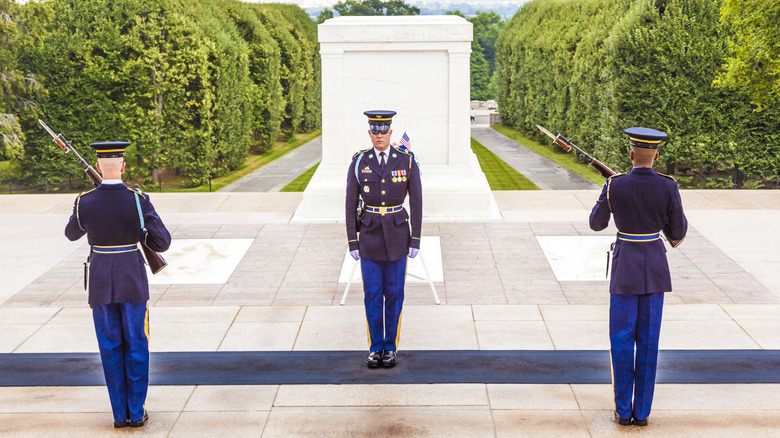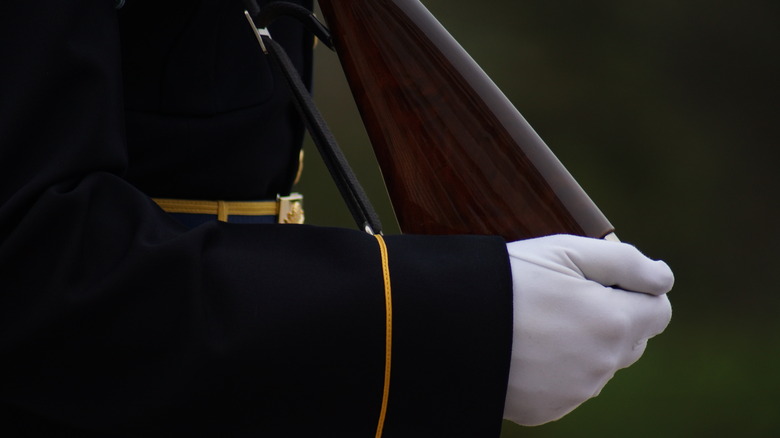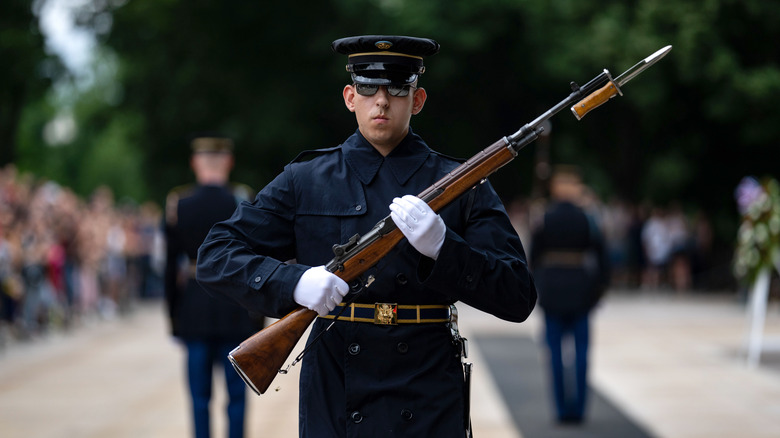Strict Rules Guards Of The Tomb Of The Unknown Soldier Have To Follow
The United States is home to several historical and sacred spaces for the military, but one that has significance unlike any other is the Tomb of the Unknown Soldier in Arlington National Cemetery. Created in 1921 as a memorial for unidentified soldiers who perished during World War I, the Tomb's meaning has evolved over the last 100+ years to honor every unidentified soldier who lost their life in warfare. It's a place with an incredibly special meaning behind it, and you may not know that one of the untold truths about the Tomb of the Unknown Soldier is that there is a dedicated group of elite soldiers who protect it with every inch of their being, and with some very specific rules.
The guards of the Tomb of the Unknown Soldier are members of the 3rd U.S. Infantry Regiment, who volunteer to keep watch over the Tomb and the brave unidentified soldiers lying in it. These soldiers go through an intensive training program, which includes an interview and several exams. If a soldier passes their training, they become a member of the Tomb Guard and start their duty. Several roles exist within this team, including sentinels, the guards who physically oversee the Tomb's protection.
It sounds like a pretty straightforward process, but make no mistake — the soldiers who guard the Tomb are expected to perfect every element of their work, from the way their uniforms look to the way they guard the Tomb itself. As such, they must follow these strict rules to meet those high expectations and honor those who gave everything for their country.
They must fall within a certain height range
The guards of the Tomb of the Unknown Soldier must meet strict criteria to be selected for the role, like having a clean record in the service and being in excellent shape. While those requirements are generally well within a prospective Tomb Guard's ability to achieve, there's one rule they have to meet but can't control; their height. The Arlington National Cemetery website states that men must fall between a height of 5 feet 10 inches and 6 feet 4 inches to be considered for a Tomb Guard position, while women must be between 5 feet 8 inches and 6 feet 2 inches tall.
Yes, that's a super-specific height requirement, but there's a reason these guards need to meet it. The Changing of the Guard is an extremely precise ceremony, with everything needing to be in alignment — including the guards' appearances. Having all the Tomb Guards fall within the same height range helps create a unified look and contributes to the uniformity of the ceremony. This dedication to keeping the guards' heights precise is also seen in the Relief teams, where soldiers are assigned to one of three teams based on their height to ensure consistency as the guard change commences.
They must memorize Arlington National Cemetery's history
The Tomb Guards don't only have to know about the Tomb of the Unknown Soldier — they must retain knowledge of the space where the Tomb lies: Arlington National Cemetery. And we're not talking about a quick one-page document with high-level details about the historical spot; we're talking about seven full pages of its history and those resting there, like William Howard Taft and John F. Kennedy, the only two presidents buried at Arlington National Cemetery. The first military burial in Arlington National Cemetery took place in 1864, so there's quite a lot of history for the guards to learn. They're also expected to memorize the final resting places of hundreds of veterans. Guards must repeat all that information (and more) from memory during a trial phase to move on to the second phase of training.
In addition to memorizing information about the Tomb and Arlington National Cemetery, guards must also learn and recite information about the United States Army and their own specific unit of the military.
They must guard the tomb 24/7 every day of the year
The Tomb of the Unknown Soldier has great significance and symbolism associated with it, as it honors unidentified service members who gave their lives in combat. Because of the significance of the Tomb, it must be guarded every second of every day to ensure its protection, whether it's a scorching summer day or a chilly winter night. Soldiers started guarding the Tomb in 1926 to deter tourists from disturbing it, but they only guarded the Tomb during the day. That changed in 1937, when the Army declared that the Tomb would be watched over non-stop.
The Tomb Guards have a rigid schedule to abide by as they keep constant watch, with the Changing of the Guard happening every 30 minutes in the summer (from early April to late September) and every hour in the winter (from early October to late March.) The timeframe of a shift extends to two hours once Arlington National Cemetery closes.
The guards must also work specific rotation shifts to ensure the Tomb is properly guarded at all times. According to the Society of the Honor Guard: "The Tomb Guards work on a three Relief (team) rotation: 24 hours on, 24 hours off, 24 hours on, 24 hours off, 24 hours on, 96 hours off." One of the untold truths of Arlington National Cemetery is just how dedicated these guards are to protecting the Tomb.
They must march exactly 21 steps down a mat
The guards of the Tomb of the Unknown Soldier have an incredibly precise routine to follow once they're on duty, and each part of the routine has a meaning. A large part of this routine is the way the guards march in front of the Tomb. According to Arlington National Cemetery, "The Guard marches 21 steps down the black mat behind the Tomb, turns and faces east for 21 seconds, turns and faces north for 21 seconds, and then takes 21 steps down the mat." That process is repeated until the Changing of the Guard occurs.
Now, we know what you may be asking yourself right now: Why do all those steps incorporate the number 21? Well, like everything the Tomb Guards do, the number 21 has a special meaning and place in the routine. It's a direct nod to the 21-gun salute, a display of high honor and respect in the military. There's a rich history associated with the 21-gun salute, as it's used to honor several notable figures, including the president of the United States and members of the British royal family.
They must carry their rifle in a specific position
Another interesting part of the Tomb Guards' routine as they protect the Tomb of the Unknown Soldier has to do with the position of their rifle. The guard will turn to walk 21 paces back down the black mat mentioned above, but before they march down the mat, they quickly and precisely place the rifle on the shoulder that faces onlookers.
The reason for this change is rooted in the mission of the Tomb Guards: To protect the Tomb at all times. The rifle resting on the shoulder facing the crowd symbolizes the guard's dedication to being the line of defense between the outside world and the Tomb. The guards protect the Tomb from any threat, including tourists leaving the designated viewing area to get a closer look. Guards can also request a crowd to quiet down if they are too loud while observing the Tomb itself and the Changing of the Guard, as silence from onlookers is expected during these times. Since they are guarding a significant monument in one of the most famous cemeteries in America, they have to be on the ball and control the crowd when necessary.
They must wear a perfect uniform
The guards of the Tomb of the Unknown Soldier take the state of their uniforms seriously, which is why they dedicate a good portion of their training to uniform preparation. Trainees take lessons on maintaining these uniforms, and once they're officially Tomb Guards, they can spend up to 10 hours each day getting their uniforms in tip-top shape, which includes shining their shoes. Uniforms are also meticulously inspected to ensure their perfection for each shift.
The guards put a lot of time and emphasis on perfecting their uniforms because of what those uniforms represent to not just themselves, but the outside world. "You putting time and putting work into your uniforms and getting them good is just the same as you doing well outside because it's honoring the Unknowns," Private First Class Isaac Redmond, a Tomb Guard, said in a video for Military Benefits back in 2013. It's not only about looking put together as you walk the plaza and watch over the Tomb; it's about looking the absolute best you can to pay tribute to all unknown soldiers.
They must keep a clean-cut appearance
Soldiers within several branches of the military have very particular guidelines to follow when it comes to their appearances, but the guards of the Tomb of the Unknown Soldier have even stricter rules to follow due to the nature of their roles. They have the visitors of Arlington National Cemetery constantly watching them, after all, which means they must have clean-cut looks to properly represent the 3rd U.S. Infantry Regiment and honor the Tomb.
The Tomb Guards do several things to achieve this specific look. For starters, they don't go more than nine work days without getting two (yes, two) haircuts. This ensures their hair is orderly and helps guards keep a similar hair length, lending to the all-important theme of consistency. Sentinels also get multiple dress uniforms (four, to be exact) and are trained to professionally steam-press them to perfection. These details help the guards maintain an ideal look that honors their unit and the unknown soldiers who made the ultimate sacrifice for their nation.
Another way the Tomb Guards show respect for the Unknowns through their appearance is by not wearing anything that reflects their rank in the service. They don't show rank to make sure those who lie in the Tomb are not outranked by those who watch over their resting place, ensuring their utmost respect and valor are upheld.
They must wear wet gloves
A pair of white cotton gloves are a must-have for the guards of the Tomb. These gloves don't just add to the guards' pristine appearance — they help them carry out an error-free walk in front of the Tomb. You see, the gloves are sprayed with water to help the Tomb Guards grip their rifles better and prevent them from fumbling the weapons or, even worse, dropping them during their shift.
The dampened white gloves are so important to Tomb Guards that there's something right on the plaza to help them stay wet. In a video, Mike Glover, a former Tomb Guard, explains that there's a spray bottle filled with water in a large green box next to the Tomb, so guards can enter and spray their gloves if needed, ensuring they have enough grip on their weapons.
It is worth noting that if you visit the Tomb of the Unknown Soldier during the winter months, you may not see the guards wearing white cotton gloves. In an interview with the Weather Channel, Herb Smith, another former Tomb Guard, says present Tomb Guards can wear leather gloves while on duty during the colder months.
They must not have a dirty rifle
It's clear the Tomb Guards follow a strict set of rules when it comes to their appearance, and those rules trickle down to their rifle. The weapon they carry as they watch over the Tomb is an important part of their overall look, and as such, the rifle needs to be in perfect condition and not have a speck of dirt on it.
If the rifle is dirty, it could spell disaster for a Tomb Guard's career. Just ask Ethan Morse, a former guard of the Tomb of the Unknown Soldier. According to Morse, one of the most detrimental things that can happen to a guard is if they fail an inspection and get sent back to the Tomb quarters — and that's exactly what happened to him after he walked out of the quarters with a dirty rifle. Morse recalls how his staff sergeant inspected the weapon by gliding his white glove over the weapon. Once he realized his glove had dirt on it, the staff sergeant sent Morse back to the quarters to get a clean weapon.
"I've made one of the cardinal sins, got sent back from the inspection block," Morse recalled in a YouTube video for AARP. "I was crying. I was at the bottom. I thought I was going to be released." Morse didn't get released over this incident, but his story serves as a cautionary tale for Sentinels: Make sure your weapon is clean before heading to the plaza.
